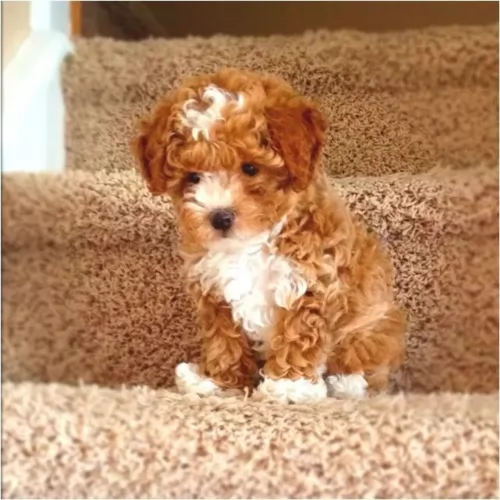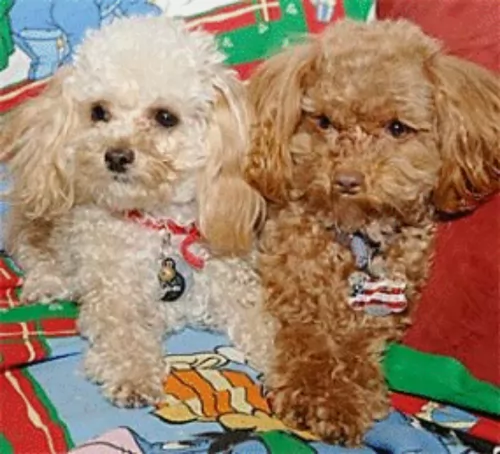 Petzlover
Petzlover Norwegian Lundehund is originated from Norway but Toy Poodle is originated from France. Norwegian Lundehund may grow 12 cm / 5 inches higher than Toy Poodle. Both Norwegian Lundehund and Toy Poodle are having almost same weight. Both Norwegian Lundehund and Toy Poodle has almost same life span. Norwegian Lundehund may have more litter size than Toy Poodle. Both Norwegian Lundehund and Toy Poodle requires Moderate Maintenance.
Norwegian Lundehund is originated from Norway but Toy Poodle is originated from France. Norwegian Lundehund may grow 12 cm / 5 inches higher than Toy Poodle. Both Norwegian Lundehund and Toy Poodle are having almost same weight. Both Norwegian Lundehund and Toy Poodle has almost same life span. Norwegian Lundehund may have more litter size than Toy Poodle. Both Norwegian Lundehund and Toy Poodle requires Moderate Maintenance.
 The Norwegian Lundehund hails from the island of Vaeroy, Norway and was created for the purpose of puffin hunting.
The Norwegian Lundehund hails from the island of Vaeroy, Norway and was created for the purpose of puffin hunting.
Now that these puffins are a protected species, the dog is no longer used for hunting and has become a companion dog.
The breed decreased in numbers during- and after World War II because the islands where he came from had an outbreak of distemper. It was in 1963 that another outbreak occurred and the dogs were almost wiped out. A breeding program saw their numbers being built up.
It was in 2011 that the dog was recognized by the American Kennel Club.
 More and more people are opting not to clip their Poodles ith those ridiculous hair cuts with pom poms. Clipped properly, he can be just as cute as any other dog.
More and more people are opting not to clip their Poodles ith those ridiculous hair cuts with pom poms. Clipped properly, he can be just as cute as any other dog.
It is thought that the Toy Poodle hails from France, with the standard poodle having originated in Germany. The first poodles were used as herders so they’re not just useless dogs with silly pom-pom haircuts.
Some rough-coated water dogs are believed to be ancestors of the Poodle. It was in the 19th century that these dogs became show dogs. Their popularity died out in the 1920s, but it has once again become a popular dog.
 As a spitz-type dog, with the Lundehund you’ll recognize the typical spitz-dog characteristics – the erect ears and the tail that curves over the back.
As a spitz-type dog, with the Lundehund you’ll recognize the typical spitz-dog characteristics – the erect ears and the tail that curves over the back.
He is a small to medium sized dog standing at 30 – 40cm and weighing 6 – 9kg. He is an active dog and is as agile as a fox.
He has a dense double coat which is white, reddish/tan with some black tips. He is a dog which sheds constantly.
Strangely this dog has 6 toes and his rear pads have elongated foot pads which have helped the dog be able to climb over rocks. He also has a flexible type of neck that is capable of craning back so that the head touches the spine. The dog has some unique features and wriggling in and out of small spaces is another of his characteristics. In fact he can do things that you would not imagine a dog could do.
When you have a Lundehund in your life you’ll agree he has a happy, amicable personality. He is non-aggressive.
He will require training and socialization as he is an independent dog who can be obstinate. He is quite aloof with strangers too and once he starts barking at them he tends to want to continue. Training him will put an end to that irritating behavior. He is a loving, loyal dog, enjoying the company of his human family.
 Toy Poodles stand between 24 to 28 cm in height and weigh in the region of 2 to 5kg. Poodles are light-shedding dogs and are thought to be hypo-allergenic. If you have an allergy, a Toy Poodle can e a great dog for you.
Toy Poodles stand between 24 to 28 cm in height and weigh in the region of 2 to 5kg. Poodles are light-shedding dogs and are thought to be hypo-allergenic. If you have an allergy, a Toy Poodle can e a great dog for you.
The crip, curly coat comes in a number of colors – cream, apricot, brown, chocolate, and black and he can be clipped if you find that he is too high maintenance. If the hair is allowed to grow it can become very matted and turn into dreadlocks.
Many Toy Poodle owners find this very difficult to maintain and opt to have the dog’s hair clipped. The poodle has medium-length floppy ears. Docking of the tail is important if you want to keep the distinctive look of your poodle. Fortunately, docking is still permitted in the USA and this is best done when the puppy is very young.
Toy Poodles are intelligent dogs and are capable of learning a whole lot of commands and tricks. They’re also excellent athletes, being lively and energetic.
Being lively and alert, the Toy Poodle can be a good watchdog too, barking sharply at intruders. The Toy Poodle is very social and won’t take kindly to being left alone for hours.
Then again, he is gentle and sensitive and won’t do well with undisciplined children and their shrill screams. They are definitely dogs that want peace and harmony. And having him trained and socialized will get you a well mannered, obedient dog. He is small enough to adapt to life in the city or the countryside.
 The Norwegian Lundehund isn’t your everyday dog and in fact he is known as a primitive breed. Perhaps he wouldn’t be the best dog to have if you’re a first-time dog owners as training is quite difficult too.
The Norwegian Lundehund isn’t your everyday dog and in fact he is known as a primitive breed. Perhaps he wouldn’t be the best dog to have if you’re a first-time dog owners as training is quite difficult too.
People who are willing to take a chance on him say that with training and socialization he can become a loving canine companion.
 This dog breed is very loyal to its family. It doesn't do well when left for hours on its own.
This dog breed is very loyal to its family. It doesn't do well when left for hours on its own.
Energetic and lively, you’ll find your Toy Poodle such a pleasure to have around. He is very intelligent too, so with training and socialization he becomes a super little pet.
Playful and social, he is like a small ray of sunshine that comes into your home and your heart.
 The Lundehund is prone to digestive disorders but even so he has got a good chance of living to be 11, 12, 13 or 14 years of age with good care.
The Lundehund is prone to digestive disorders but even so he has got a good chance of living to be 11, 12, 13 or 14 years of age with good care.
He is however, one of these dogs prone to health problems of which chronic intestinal disease is one. Its the kind of illness that can recur because it is resistant to treatment.
Experts on these dogs say that they should have a fecal test done every 6 months or so, saying that one thing a bit negative with this dog breed is that you may well be forking out quite a bit on chronic veterinary care.
 Good food and exercise keep the Toy Poodle as healthy as possible, but like other dogs, the Toy Poodle can also get sick. Cancer, bloat, ear infections, and obesity are common dog ailments.
Good food and exercise keep the Toy Poodle as healthy as possible, but like other dogs, the Toy Poodle can also get sick. Cancer, bloat, ear infections, and obesity are common dog ailments.
Too many dog owners don’t realize the importance of healthy teeth. You need to look into the mouth of your pet regularly to make sure there are no rotting teeth. These problematic teeth can jeopardize the health of your pet.
Infection of teeth and gums can cause a host of other problems such as kidney and heart disease.
Check your Toy Poodle for parasites – fleas, ticks, worms as these can take a toll on your pet’s health. Your pet can become lethargic and the coat becomes listless, thin and dull. Your pet will also lose weight. Speak to your vet about treatments that can prevent these infestations.
 Like any other dog, the Norwegian Lundehund will do well on the best quality food. If you buy him commercially manufactured food, check the ingredients on the packaging. Lots of these lower quality foods are made from ingredients that are toxic for your pet, so buy a good quality one.
Like any other dog, the Norwegian Lundehund will do well on the best quality food. If you buy him commercially manufactured food, check the ingredients on the packaging. Lots of these lower quality foods are made from ingredients that are toxic for your pet, so buy a good quality one.
Buy food according to your dog’s age and activity levels. To make his meals more interesting, add in some delicious home prepared food for him. Stay away from spicy, exotic foods and go for something like boiled chicken, brown rice and vegetables. Some raw meat added to the kibble from time to time can also do wonders for your pet as he requires a high-protein diet. Make sure he always has access to fresh, cool water.
Other ‘caring’ things to do to make sure your pet has a quality lifestyle is -
Brush his hair twice a week as he is a fairly heavy shedder. Not only does it keep the coat nice and shiny, it builds up a bond between you and your pet.
Check his ears and eyes regularly to make sure they are free from infection.
Clip his nails when they get long as your pet can hurt himself if the nails hook onto things.
Whenever he is ill, get him to the vet for a check-up.
Make sure he has a nice safe, dry, warm, snug place to sleep.
Keep him well exercised. A dog that is put into the backyard and more or less forgotten will be most miserable. Why get a pet if you don’t want to make him a 100% part of the family?
 Make sure to exercise your Toy Poodle every day. If you’re lucky to have a garden, play ball games with him, play hide and seek and take him for walks.
Make sure to exercise your Toy Poodle every day. If you’re lucky to have a garden, play ball games with him, play hide and seek and take him for walks.
Brush your Toy Poodle twice a week. His curly coat can become a source of concern for you and then you can have his coat clipped short.
Provide your pet with training and socialization and get him used to walking on a leash.
Take your Toy Poodle for regular visits to the vet. There are some serious canine diseases that can kill your pet.
Provide your pet with a nice dry, peaceful sleeping area. He needs his own water and food bowls. Wash these regularly.
Provide your Toy Poodle with the best dog food there is. Try and go for natural foods free from colorants and fillers. Try and also give him some home-made food such as boiled chicken, brown rice, sweet potatoes, and spinach. Dogs like the same good foods which are simple and nutritious.